Mantle plume:the dynamic setting of the origin of Early Paleozoic mafic dykes in Ziyang,Shaanxi Province,Southern Qinling Block,China
2020-06-22XiaoqingChenShenLiuCaixiaFengIanCoulsonYanFanKairuiTaiTianjingGaoSiyuanZhang
Xiaoqing Chen·Shen Liu·Caixia Feng·Ian M.Coulson·Yan Fan·Kairui Tai·Tianjing Gao·Siyuan Zhang
Abstract The mafic dykes (dolerites) during the Early Paleozoic are widely spread in Langao-Ziyang,southern Qiling Block,and the investigation on these dykes are very important.Previous studies have mainly focused on the Silurian mafic dykes; however,research on the Earlier Paleozoic mafic dykes is relatively weak at present.Therefore,the overall understanding of the mantle source and genetic dynamic setting during the Early Paleozoic in this area is lacking.To study the accurate age and origin of the Early Paleozoic mafic dykes in Ziyang,southern Shaanxi Province,the mafic dykes from dabacunand Qinmingzhai were selected and the petrology,zircon U–Pb chronology,geochemistry,and Sr–Nd–Hf isotopes were studied.Analysis indicates that the mafic dykes studied are mainly composed of dolerite,and they are the products of the Early Ordovician (475.8–480.7 Ma).Furthermore,the dolerites belong to alkaline rock series,and they are characterized by enrichment in LREE,Rb,Ba,Sr,Nb,(87Sr/86Sr)i=0.7020–0.7050,εNd(t)=3.0–4.0),εHf(t)=4.5–12.1,176Hf/177Hf=0.282681–0.282844.This suggests that the mafic dyke were derived from the partial melting of a depleted lithospheric mantle,and the genetic process is mainly controlled by the mantle plume based on the discussion of the genetic model.Furthermore,the genetic process experienced the separation and crystallization of olivine and clinopyroxene at the same time,with little crustal contamination.
Keywords Early Paleozoic·Dolerites·Geochemistry·Origin·Mantle plume
1 Introduction
As a result of the collision between the North China Craton(NCC) and Yangtze Block during Late Triassic,for a long time,the Qinling Orogenic Belt has become one of the hot spots of widespread concern and research.Currently,previous studies have shown that the Earlier Paleozoic mafic dyke and alkaline dyke swarms (Zhang et al.2002,2007,433 Ma; Deng et al.2003; Yan 2005,413–471 Ma; Chen et al.2006,440 Ma; Wang 2007,2009,431 Ma; Li 2009;Zhang 2010,438 Ma; Zou et al.2011,440 Ma; Xie et al.2014,410 Ma; Chen et al.2014,422 Ma; Long 2016,415–433 Ma; Zhang et al.2017,425 Ma),bimodal volcanic rocks (Yan 2005),large-scale mineralization (Chen et al.1994;Qi et al.1999;Deng et al.2003;Tu 2006;Zeng et al.2007; Tang et al.2007; Wu et al.2010; Wei et al.2016; Zhu 2017),rift valley and fault basin (Yang 1985;Kuang et al.1995; Zhang et al.2001,2012; Zeng et al.2007;Tang et al.2007),thrust nappe structure(Zhang et al.2001; Liu 2008),and metamorphic core complex (Zhang and Zheng 1999)are widely spread in the Southern Qinling Region.The above typical geological features indicate that the South Qinling Block was in a strong lithospheric extension stage during the Early Paleozoic.At the present,though some studies have been made on the Eearly Paleozoic lithospheric extensional characteristics in Southern Qinling Block,there is still a lack of systematic studies on the lithospheric extension period,mantle source,and genetic dynamic setting in the extensional setting.Further relevant research thus is necessary.As a representative product of lithospheric extension and fragmentation,mafic dyke swarms are mafic rock assemblages with the same/similar occurrence in the same magmatic event under the background of crustal extension,and the rock composition mainly includes lamprophyre,dolerite,and diabase porphyry (Shao and Zhang 2002; Liu et al.2010a,b,c).Furthermore,the investigation on these rocks has special research significance (Hall 1982; Li 1990; Li et al.1997; Shao and Zhang 2002; Xie 2003; Zhao 2004;Zhao et al.2004; Peng et al.2004; Yan 2005; Liu et al.2004,2006,2008a,b,2009,2010a,b,c,2012a,b,2013a,b,c,d,e,f,2015,2016,2017a,b,2018;Wang et al.2008;Feng 2012; Yang 2012,2013; Tang 2013).At present,the research period of the Early Paleozoic mafic rocks in the South Qinling Block is mainly concentrated in the Silurian(410–440 Ma); by contrast,the understanding of the mafic dykes in the extensional setting during the Ordovician and Cambrian is still weak.In this paper,mineralogy,LA-ICPMS zircon U–Pb dating,rock and isotope (Sr–Nd–Hf)geochemistry are used.The origin and geodynamic setting of the mafic dykes during Ordovician (476–481 Ma) from Ziyang area were discussed.
2 Regional geological backgrounds and petrological characteristics
As a very important intercontinental orogenic belt across the east and west of China,Qinling Orogenic Belt is generally divided into three parts:the southern margin of the North China Block,the northern margin of the Yangtze Block and the southern Qinling Block by Shangdan and Mianlue suture zones(Yan 2005).Meanwhile,Qinling Orogenic Belt can be further divided into the southern margin of the North China massif,the thick-skinned imbricate thrust belt of the North Qinling Block,the foreland thrust fold belt of the Qinling Orogenic Belt,the giant nappe front thrust belt of the southern margin of the Bashan-Dabie Mountains,the northern thrust nappe belt of the South Qinling Block,the arc thrust nappe system of the Bashan Mountains in the South Qinling Orogenic Belt,the Nandan fault system and the Mianlue fault(Zhang et al.2001).
The South Qinling Block is mainly located between the Shangdan Fault zone and the Mianlue-Bashan Arc Fault zone.The West of this block corresponds to the West Qinling and Qaidam massif,and the East includes Wudang,Suizhou,and Tongbai-Dabie block.The south Qinling Block belongs to the northern margin of the Yangtze Plate Pre-Late Paleozoic.Subsequently,with the opening of the Mianlue oceanic basininthe Late Paleozoic,itgraduallyseparatedand formed a relatively independent micro-plate.But until the Early Mesozoic,with the collision and amalgamation with the North China and Yangtze Plates,it eventually became an important part of the Qinling Orogenic Belt (Zhang et al.2001;Yan 2005).Paleozoic magmatic rocks mainly occur in Langao-Ziyang area south of Ankang,South Qinling Block.The area studied in this study is located in Ziyang Daba village and Qingmingzhai area(southern Ankang),South Qinling Block.The outcropped strata mainly include the Cambrian,Early-Middle Ordovician and Early Silurian(Fig.1).The main exposed rocks in South Qinling Block include mafic dyke,gabbro,alkaline complex and granitic rocks (Wang 2007).The mafic dykes occur as dykes with NW–SE orientations,and the dykes studied were mainly composed of dolerites,which intrude the Cambrian and Early Ordovician sedimentary basement rocks.Single dykes can range between 4.0 and 110 km in length and 0.6–8.0 km in width (Figs.2,3).All of the dolerites are characterized by black-gray and grey-green,massive(with a small number of bubbles),medium-fine texture,the dolerites studied diabasic with secondary-authentic 30 %–36 % clinopyroxene,(3.0–5.0 mm),65 %–70 % plagioclase (2.0–4.0 mm),olivine,biotite,quartz,apatite,magnetite,and ilmenite(Fig.3).Moreover,the clinopyroxene is usually altered into a mixture of chlorite,amphibole,and carbonate,and plagioclase is partly replaced by albite,epidote,and kaolinite.Surrounding rocks in the study area mainly includes thick striped silty limestone with silty limestone and lens of bioclastic limestoneoftheCambrianMaobaguanFormation,thin-layerfinegrained limestone and bioclastic limestone intercalated with grey medium-thick silty limestone of Baguamiao Formation,thick to super-thick gravel limestone,beaded limestone with muddy streaked siltstone,grey calcareous slate with siltstone,muddy limestone and sandy clastic limestone of Heishuihe Formation.The Ordovician Gaoqiao Formation lime-green viscous slate with silt marl,beaded micrite and banded calcviscous slate interblended,gray viscous slate,calc-viscous slate with limestone thin beds,black-gray striped viscous slate of Quanhekou Formation with carbonaceous siliceous viscous slate,feldspar quartz sandstone and siltstone.The Silurian porphyry viscous slate,carbonaceous viscous slate,silty slate,silty slate with feldspar quartz siltstone also was found(Fig.1).
3 Analytical methods
3.1 U-Pb dating by LA-ICP-MS

Fig.2 The field Profile of dolerites studied
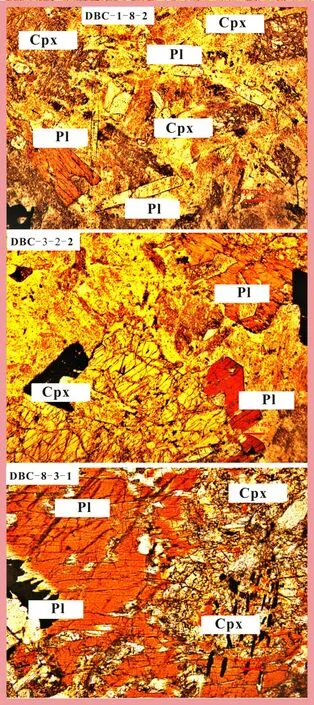
Fig.3 The microscopic photos of the dolerite thin sections in the study area.Cpx:clinopyroxene; Pl:plagioclase
Zircon grains from three of the investigated dolerite samples studied (DBC-1,DBC-2,and DBC-3) in Shaanxi Province were separated using conventional heavy liquid and magnetic techniques.Representative zircon was then hand-picked under a binocular microscope before being mounted in an epoxy resin disc,polished,and then coated with gold prior to analysis.Zircons were documentedwith transmitted and reflected light as well as cathodoluminescence images to reveal their external and internal structures at the State Key Laboratory of Continental Dynamics,Northwest University.Laser ablation techniques were used for zircon age determinations(Table 1).The analyses were conducted with an Agilent 7500a ICPMS equipped with 193 nm excimer lasers,which is housed at the State Key Laboratory of Geological Processes and Mineral Resources,China University of Geoscience in Wuhan.Zircon 91500 was used as astandard and NIST 610 was used to optimize the results.The spotdiameter was 24 μm.The analytical methodology is described in detail in Liu et al.(2007) and Yuan et al.(2004).Common-Pb corrections were made using the method of Andersen (2002).Data were processed using the GLITTER and ISOPLOT (Ludwig,2003)programs.Errors on individual analyses by LAICP-MS are quoted at the 95 % (1σ) confidence level(Fig.4).
3.2 Major elemental and trace elemental analyses
Major element compositions were determined using analytical Axioms-advanced X-ray fluorescence (XRF) spectrometer at the State Key Laboratory of Ore Deposit Geochemistry (LODG),with an analytical precision of better than 5 %.Trace element compositions were determined by Inductively-coupled plasma mass-spectrometry(ICP-MS) utilizing a Perkin-Elmer ELAN DRC-instrument at the LODG.Prior to analysis,powdered samples(50 mg) were dissolved in high-pressure Teflon bombs,using an HF+HNO3attack for 48 h at about 190 °C (Qi et al.2000).Moreover,signal drift during the analysis was monitored using Rh as an internal standard.GBPG-1,OU-6,GSR-1,and GSR-3 standards were used for analytical quality control with a determined analytical precision of better than 5 %.
3.3 Sr-Nd-Hf isotopic analyses
For the analysis of Rb–Sr and Sm–Nd isotopes,sample powderswere spiked with mixed isotope tracers,dissolved in Teflon capsuleswith HF+HNO3acids,and separated by conventional cation-exchange techniques.Isotopic measurements were performed using a Finnigan Triton Ti thermal ionization mass spectrometer (TIMS) at the LODG.Procedural blanks were <200 pg for Sm and Nd,as well as <500 pg for Rb and Sr.Mass fractionation corrections for Sr and Nd isotopic ratios were based on86Sr/88Sr=0.1194 and146Nd/144Nd=0.7219,respectively.Analyses of standards yielded the following results:NBS987 gave87Sr/86Sr=0.710246 ± 16 (2σ) and La Jolla gave143Nd/144Nd=0.511863 ± 8 (2σ).The analytical results for Sr–Nd isotopes arepresented in Table 4.
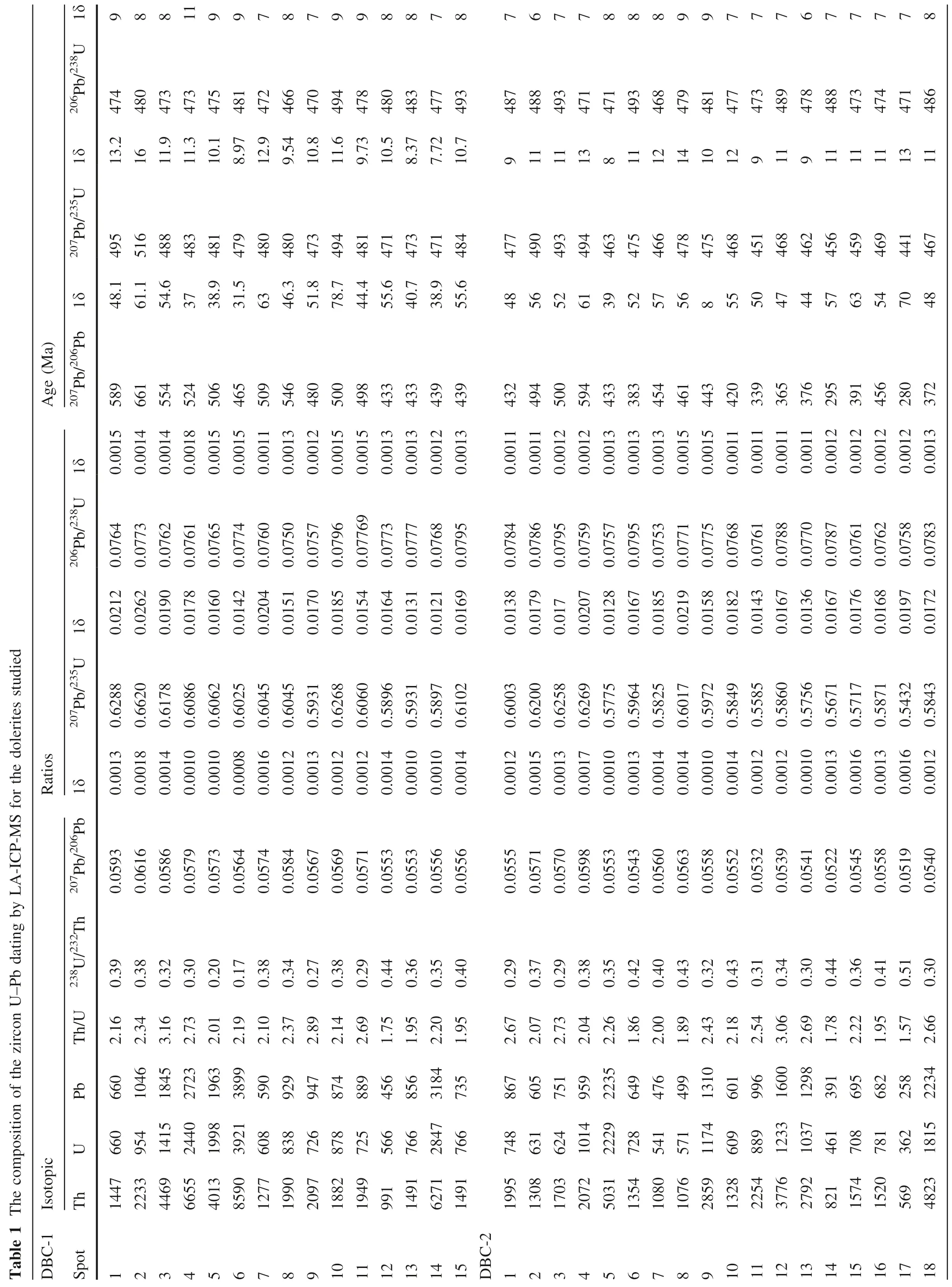

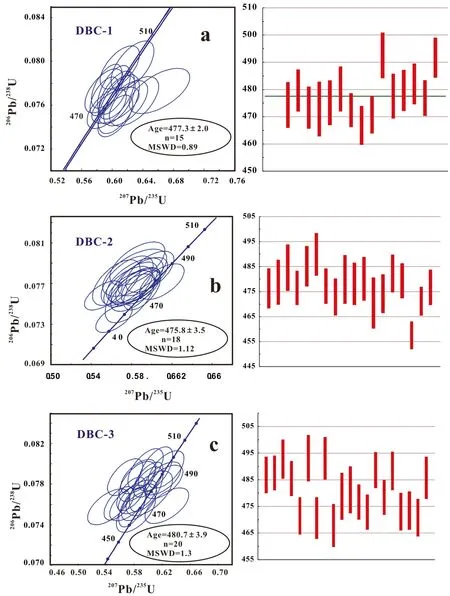
Fig.4 The LA-ICP-MS zircon U–Pb dating of the dolerites studied
In-situ zircon Hf isotopic analyses were undertaken using a multi-collector-inductively coupled plasma-mass spectrometer equipped with a Geolas-193 laser at the Key Laboratory of Continental Dynamics,Northwest University.These analyses used a laser repetition rate of 10 Hz at 100 mJ and a beam diameter of either 32 or 63 μm.The isobaric interference of176Lu on176Hf was corrected by measuring the intensity of the interference-free175Lu isotope and using a recommended176Lu/175Lu ratio of 0.02655 (Machado and Simonetti 2001).A176Yb/172Yb value of 0.5887 (Chu et al.2002) and mean βYbvalues obtained during Hf analysis were used to correct for the interference of176Yb on176Hf (Iizuka and Hirata 2005).Details of the analytical and data correction procedures are given in Wu et al.(2006).Our analyses included measurements of standard 91,500 and FM0411 zircons,yielding mean176Hf/177Hf ratios of 0.282313 ± 36 [2 standard deviations(SD),n=35]and 0.282996 ± 31(2SD,n=9),respectively,which agree with the reported176Hf/177Hf composition of the 91500 zircon (0.282306 ± 8,2SD,n=30) by solution analysis (Woodhead et al.2004) and 0.282983 ± 17(2SD,n=9)for the FM0411 zircon by insitu analysis (Wu et al.2006).
4 Results
4.1 Zircon U-Pb geochronology
Characterization of CL images indicates that selected dating zircons have complete automorphism and are generally columnar with obvious magmatic zones.The Th(501–8590 ppm) and U (362–3921 ppm) composition are relatively high;the range of Th/U ratio is between 1.57 and 8.54 (Table 1).As a result,the chronological zircon cathodoluminescence photographs are darker(Ewing 1994).Also,there is no inherited zircon in zircon grains.Euhedral zircon grains in samples DBC-1,DBC-2,and DBC-3 were observed to be clean and prismatic,with evident oscillatory zoning,suggestive that these were the products of magmatic crystallization.A total of 15 zircon grains provided a weighted mean206Pb/238U age of 477.3 ± 2.0 Ma (1σ)(95 % confidence interval,MSWD=0.89) for DBC-1; 18 zircon grains gave a weighted mean206Pb/238U age of 475.8 ± 3.5 Ma (1σ) (95 % confidence interval,MSWD=1.12)for DBC-2;20 grains gave a weighted mean206Pb/238U age of 480.7 ± 3.9 Ma (1σ) (95 % confidence interval,MSWD=1.3) for DBC-3.These determinations are the best estimates of the crystallization ages of the dolerites investigated.
4.2 Major and trace elements
Whole-rock geochemical data for the dolerites studied in Tables 2 and 3.The dolerite samples exhibit a fairly wide range of compositions:SiO2(41.72–45.23 wt%),TiO2(3.02–5.52 wt%),Al2O3(12.26–18.52 wt%),Fe2O3(12.15–15.69 wt%),MnO (0.14–0.24 wt%),MgO(3.27–5.98 wt.%),CaO (9.05–11.32 wt%),Na2O(2.90–3.98 wt%),K2O(0.40–1.55 wt%),P2O5(0.42–01.43 wt%),and Mg#(36–48),and a medium ignition (LOI,2.62–4.18) (Table 2).The dolerite samples studied all fall into the alkaline field in terms of the total alkali-silica(TAS) diagram (Fig.5).The dolerites studied exhibit negative correlations between SiO2and TiO2,Fe2O3,and MgO (not shown).The samples studied are also characterized by LREE enrichment and HREE depletion,with a wide range of Eu/Eu*ratio(7.75–11.9)and(La/Yb)Nratio(7.75–11.5) (Table 3 and Fig.6a,b).On primitive mantlenormalized trace element diagrams,the dolerites studied show enrichment in LILEs (i.e.,Rb,Ba,Th,and Sr),Nb,and Ta,and depletion for Pb,Hf,and Ti (Fig.6b).
4.3 Sr-Nd-Hf isotopes
Sr and Nd isotopic data for 12 representative dolerites studied and Hf isotopic composition for 3 zircon samples(DBC-A,DBC-2,DBC-3)are presented in Tables 4,5 and Figs.7,8.The investigated dolerites show a wide range in(87Sr/86Sr)ivalues of between 0.7020 to 0.7050 and positive composition in εNd(t)values,from 3.0 to 4.0,which suggests source areas with slight depletion.A total of 19 spot analyses were undertaken on sample DBC-1,yielding uniform εHf(t) values between 6.4 and 10.5 that correspond to TDM2model ages of 908–1279 Ma.A further 19 spot analyses on sample DBC-2 yield another narrow range ofεHf(t) values between 6.4 and 10.7 and TDM2model ages of 770–1040 Ma.A total of 20 spot analyses on sample DBC-3 yielded a relatively wide range of εHf(t) values (from 4.5 to 12.1) that correspond to TDM2model ages of 571–1450 Ma.
5 Discussion
5.1 Source,crustal contamination,and fractional crystallization
The dolerites studied was provided with relatively low(87Sr/86Sr)i(0.7020–0.7050),positive εNd(t) (3.0–4.0) and εHf(t) value (4.5–12.1) (Tables 4,5; Figs.7,8,9),which indicates that the dykes were derived from partial melting of depleted lithospheric mantle or asthenosphere(e.g.,midocean ridge basalt; Liu et al 2016,2017b).Nevertheless,the dolerites studied are characterized by relatively low Nb/Ta ratio (10.4–12.6),the average is 11.4,and these characteristics are clearlydifferent from those of mid-ocean ridge basalts (Nb/Ta=17.7; Sun and McDonough 1989).Also,it suggests that magmatic origin may be influenced by crustal contamination (Green 1995).In general,crustalcontamination can result in Nb–Ta depletion and relative enrichment of Sr–Nd isotopes in mafic rocks (Guo et al.2004).However,these geochemical characteristics have not been observed in the mafic dykes studied (Figs.6b,7).Moreover,on the plots of Nb/Ta vs.La/Yb,Ce/Nb vs.Th/Nb,Th/Nb vs.Ta/Yb,and La/Nb vs.Ce/Pb(not shown),no significant correlation was found for the dolerites studied.The obvious crustal contamination thus is negated during the diagenetic process.This is further supported by relatively high Ce/Pb ratio (36–55),positive Nb anomaly,negative Pb anomaly,and lack of inherited zircon (Hofmann 1988;Zhang et al.2002).It is generally accepted that fractional crystallization is the most important mechanism for the differentiation and evolution of mafic magma.Firstly,fractional crystallization was supported by the low Cr (almost all less than 15.0 ppm),Ni composition,and Mg#value (36–48) (Liu et al.2018).Furthermore,the negative between SiO2and TiO2,Fe2O3,and MgO provide credible evidence for the separation of olivine and clinopyroxene.However,separation of plagioclase and Tibearing minerals such as rutile and ilmenite are excluded(Liu et al.2018).

Table 2 The major elemental composition of the dolerites studied (wt%)
5.2 Genetic model
On La vs.La/Sm plot,the projection point of the dolerites show an obvious positive correlation (Fig.9),indicating that they were derived from partially melting of a depleted lithospheric mantle.Based on the above discussion,the rising melt was also affected by little crustal contamination during the ascent.Nevertheless,a dynamic model is still needed to explain the origin of these dolerites.At present,there are three possible genetic models for the dolerites studied:(1)contribution of Subduction Yangtze Block(Liu et al.2018); (2) the role of subduction of the Paleo-Pacific Plate (e.g.,the Izenaki Plate); and (3) the dolerites studied may be the product of continental rift environment (Wang 2007).However,it is generally accepted that the final collision between the NCC and Yangtze Block occurred in the Late Triassic (Meng and Zhang 1999; Zhang et al.2001; Zhang 2001; Yan 2005).Furthermore,there is no westward subduction of the Paleo-Pacific Plate to the NCC occurred before the Early Cretaceous.Because the mafic dykes did not emplace until the Early Paleozoic,the genesis process thus should not be related to the subduction of the Yangtze lithosphere or the Paleo-Pacific plate.The genetic model of the dolerites studied thus is still pending.At present,although great achievements have been made for QinlingOrogenic Belt,there are still fierce disputes about the Early Paleozoic tectonic evolution of South QinlingOrogenic Belt.Therefore,it is no doubt very important to study the rocks (such as mafic dykes and alkaline complexes) which have obvious indicative effect on structural evolution.


Fig.5 The correlation diagram between SiO2 vs.Na2O+K2O of the dolerites studied
Alkaline complex is widely distributed in South Qinling structural belt,based on petrology,mineralogy and geochemistry investigation,Wang (2007) suggest that these rock belongs to bimodal volcanic rock,and they were formed in a rift tectonic environment,the development of continental rift and associated magmatic activity are related to mantle plume activity,although the deep dynamic characteristics of rift structural exchange need to be further explored.Meanwhile,the continental rift resulted in lithospheric extension.In general,the South Qinling Block is generally in an extensional environment during the Early Paleozoic (700–447 Ma),suggesting that the whole South Qinling has a similar dynamic background at this time(Yan 2005).In general,the extensional tectonic environment is related to the deep slow material movement(or the mantle plume).When the rift extends to a certain extent,the lower slow material will rise to the upper crust or the surface of the crust along the relevant region due to the weakening of the upper crustal stress,and then form largescale mafic dyke swarms,alkaline rock,and bimodal volcanic rock (Yan 2005;Liu et al.2004,2006,2008a,b,2009,2010a,b,2012a,b,2013a,b,c,f,2015,2016,2017a,b,2018).

Fig.6 The Chondrite normalized REE patter and Primitive mantle normalized trace element.Patter of the dolerites from the study area(Sun and McDonough 1989)
At present,the mantle plume theory has been successfully applied to the to continental dynamics (e.g.,lithospheric extension,and rift) (Morgan 1971; Condie 1976;Hofmann and White 1982; Breithopf 1989; Griffiths and Campbell 1990; Hill et al.1992; Davies and Richards 1992; Hull 1993; White and Kenzie 1995; Wang et al.1997;Wedepohl and Baumann 1999;Li et al.1999;Wang 1998,2001;Zhang 2001;Xu et al.2001;Yan 2005;Li and Yang 2011; Thompson and Gibson 2019),geomagnetic polarity,biological extinction,and climate change.There are at least 45 mantle plumes in the world,including 14 on continents and more than 30 on the ocean (e.g.,Hawaii,Yellow stone,Iceland,Afar,Pacific Ocean,Atlantic Ocean,Emei,Wang 1998,2001).Nowadays,the geochemical identification of the basalts from different ages in the Qinling Orogenic Belt indicates that the mantle plumederived magmatism in the South Qinling Orogenic Belt began in the Late Mesoproterozoic(Zhang et al.2001).The formation of the mafic-bimodal volcanic rocks,ophiolite,alkaline,and mafic dykes before the Silurian in South Qinling Orogenic Belt is related to the mantle plume activity rather than the contribution of lithospheric mantle material(Zhang et al.2002),which is further supported by the deep-water basins of the Ordovician continental margin rift with rich silicon and carbon were developed on the passive continental margin the Early Paleozoic in South Qinling Block (Wang.2007),magmatic complex intruded into the sedimentary rock series of the rift,enrichment of LREE,Nb,and Ta,Th/Hf (more than 0.3),lower Th/Ta ratio (0.41–2.68) and depletion of Pb composition(Trevon 1995;Zhang 2001;Xu et al.2001;Zhang et al.2002,2007;Yan 2005; Li and Yang 2011).These characteristics have been shown in the dolerites studied (higher Th/Hf=0.42–0.63,lower Th/Ta=0.50–1.19; Table 3),and depletion of Pb (Fig.6b),suggesting that these dolerites should be the product of the typical magmatic activity of the mantle plume (Zhang 2001; Yan 2005).This is further supported by the multi-stage bimodal sedimentary-volcanic formation and structural variation characteristics of the ophiolite and North China-Yangtze Block in the Qinling Orogenic Belt (Yan 2005).

Previous geochemical identification of mantle source types in different periods of QinlingOrogenic Belt indicates that the magmatic activity of mantle plume in North Qinling Block began in the Paleoproterozoic,while that in South Qinling Block began in the late Mesoproterozoic,and that different mantle plume activities migrated from north to southwith time (Zhang 2001).In the Early Paleozoic,mantle plume activity thus mainly occurred in the Mianlue-Ziyang-Langao line.In the Late Paleozoic,the center of mantle plume activity moved further southward,and a large-scale Emeishan overflow basalt was formed in southwestern China.0n Ta/Hf vs.Th/Hf and Th/Zr vs.Nb/Zr plots(not shown),all dolerites studied fall in the field of a mantle plume,the dolerites studied also show characteristics similar to OIB-type basalts on the primitive mantle normalized plot (Fig.6b).Furthermore,the dolerites studied are characterized by enrichment of Rb,Ba,and Sr and light rare earth elements,Ta/Hf=0.77–0.91 and Th/Ta=0.54–1.19 (Table 3).Based on the above discussion,the dolerites studied are the typical product of mantle plume magmatism during the Early Paleozoic.The upwelling of deep mantle plume leads to an extensional extension of the overburden crust;it not only intensifies the activity of the original fracture system but also produces a series of radial fracture systems centered on the axis of a mantle plume.The formed radial fissure system thus becomes an advantageous channel for magma ascension.At the end of magmatism,the unexploded magma emplaced and consolidated to form large-scale radial mafic dyke swarms and related igneous rocks (Zhang et al.2002,2007,2017;Wang 2007;Li 2009;Zhang 2010).The thickness of the lithosphere is large more than 150 km,as low degree,partial melting occurs in the mantle source area under high pressure.Garnet becomes the main residual mineral phase,resulting in loss of Y and HREE in the melt,enrichment of strong incompatible elements and enrichment of MgO (Griffiths and Campbell 1990; Hill et al.1992; Hull 1993; White and Kenzie 1995; Wang et al.1997; Wedepohl and Baumann 1999; Wang 1998,2001;Zhang 2001; Zhang et al.2002).
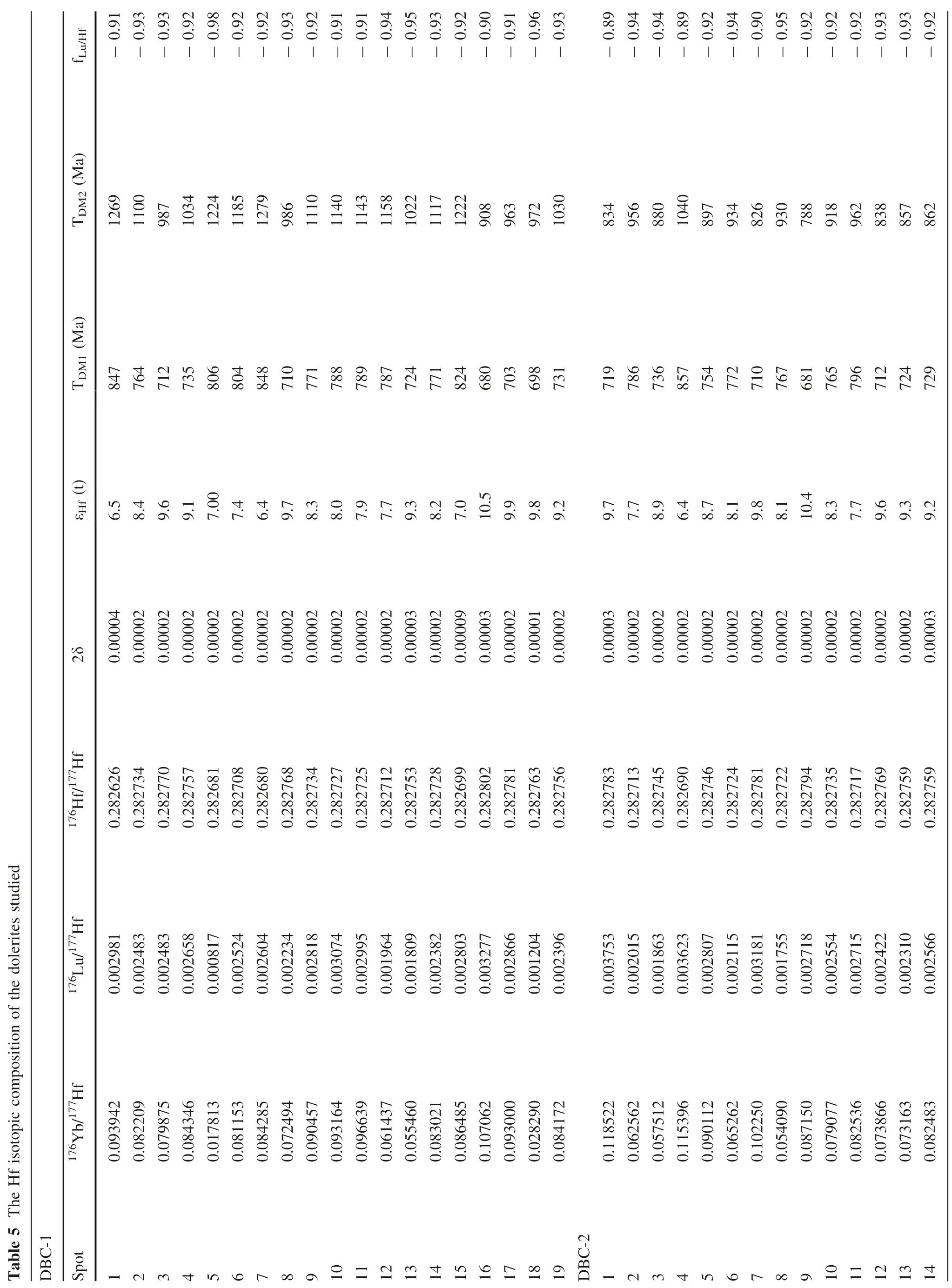

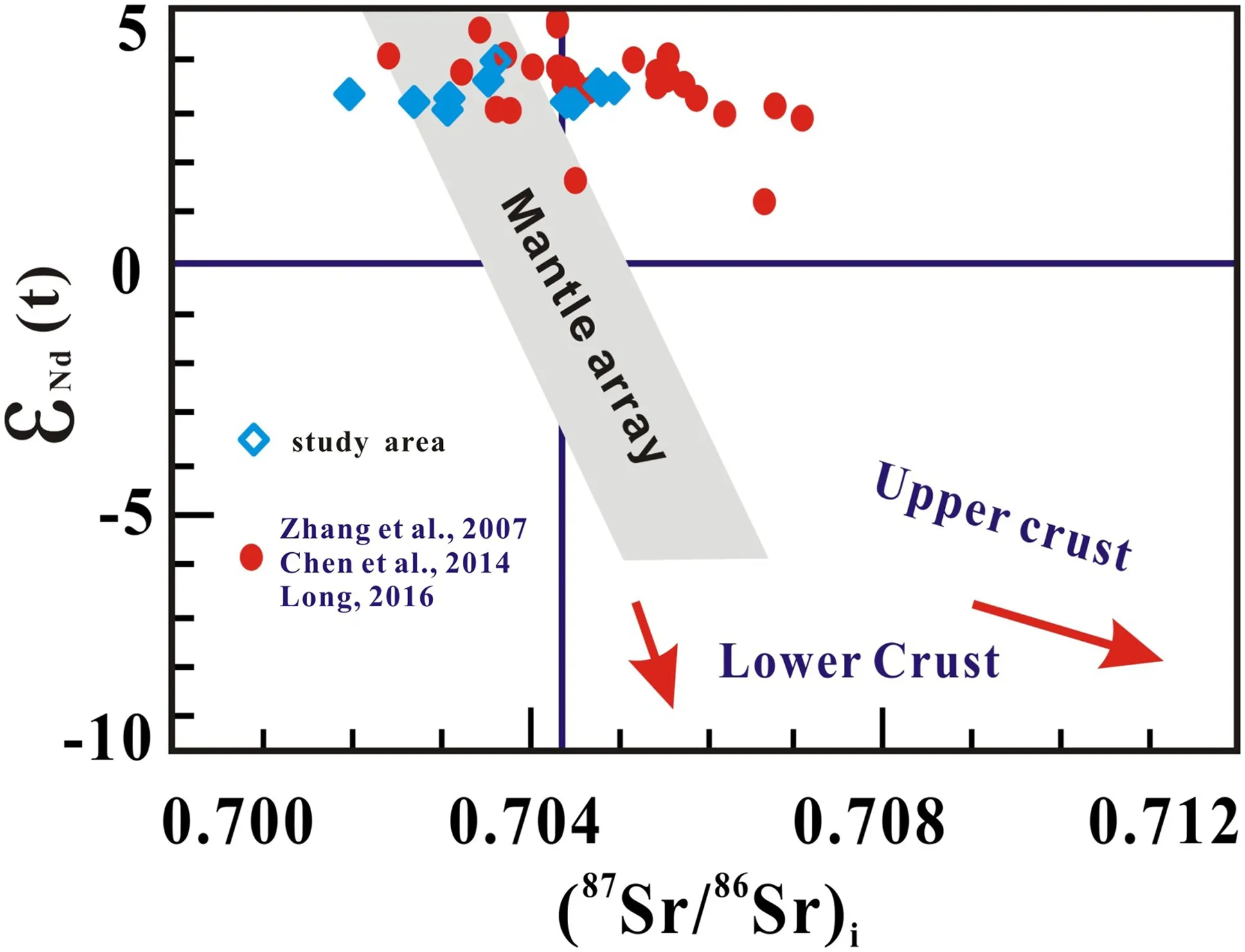
Fig.7 The (87Sr/86Sr)i vs.εNd(t) plot of the dolerites studied
6 Conclusions
Integrated U–Pb geochronology,whole-rock elemental geochemistry and Sr–Nd-Hf isotopic studies of suites of mafic dykes from the Ziyang within Shaanxi Province allow us to conclude as follows.
1.The mafic/dolerite dykes from the study area were intruded during the Early Paleozoic (Ordovician) as evidenced in the newly determined zircon U–Pb geochronological ages,of 475.8 ± 3.5 Ma to 480.7 ± 3.9 Ma.
2.All mafic rocks studied have an affinity to alkaline igneous suites.These are enriched in LREE [(La/Yb)N=7.75–11.5],and select LILE (e.g.,Rb,Ba,Sr,Nb,Ta,Zr,and Hf),and Eu,and depleted in Th,U,Pb,and Ti relative to a primitive mantle.The dykes studied have low initial87Sr/86Sr ratios(0.7020–0.7050),positive εNd(t) (3.0–4.0),and εHf(t) (4.5–12.1) values.This indicates that the dolerites studied were derived from partial melting of depleted lithospheric mantle.

Fig.8 The εHf (t) histogram of the dolerites studied
3.Fractionation of olivine and clinopyroxene occurred during magma ascent,with smaller crustal contamination.The geodynamic mechanism ofthegenetic process is mainly controlled by the mantle plume activity in Qinling.
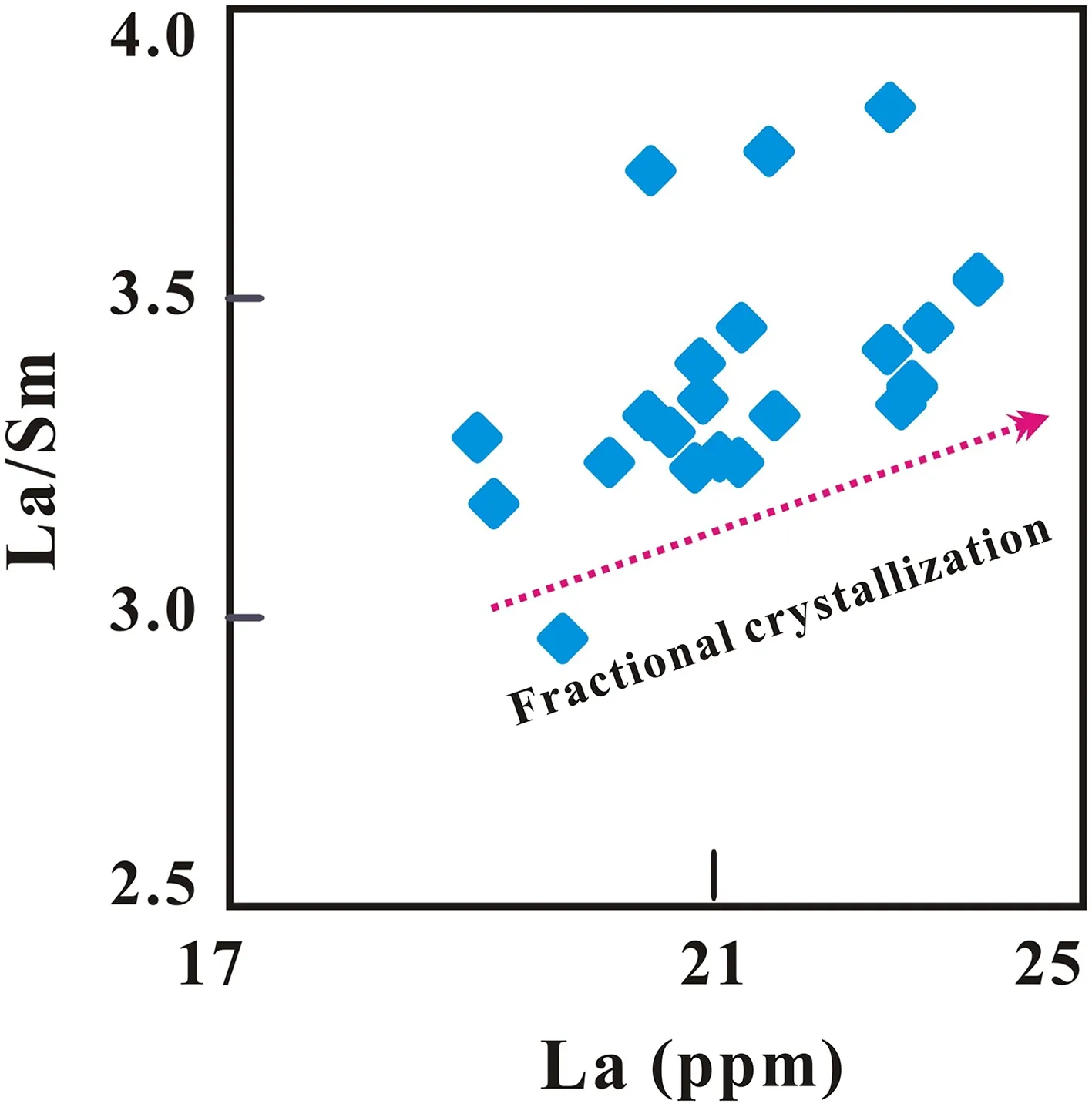
Fig.9 Correlation diagram of La and La/Sm for the dolerites studied
AcknowledgementsThe authors thank Dr.Shuqin Yang for assistance during the XRF analyses,Prof.Liang Qi and Xiaobiao Li for assistance during ICP-MS analyses,the technician for assistance during TIMS Sr–Nd isotopic analyses,and Profs.Xiaoming Liu for assistance during LA-ICP-MS U–Pb dating.This study was supported by the National Natural Science Foundation of China (Grant:41573022).
杂志排行
Acta Geochimica的其它文章
- In-situ nitrogen fate in the vadose zone of different soil types and its implications for groundwater quality in the Huaihe River Basin,China
- Organic geochemistry of the Lower Permian Tak Fa Formation in Phetchabun Province,Thailand:implications for itspaleoenvironment and hydrocarbon generation potential
- Using Sr isotopes to trace the geographic origins of Chinese mitten crabs
- Geochemical characteristics and origin of the Neoproterozoic high-K calc-alkaline granitoids in the northern part of Mandara hills,northeastern Nigeria
- A re-assessment of nickel-doping method in iron isotope analysis on rock samples using multi-collector inductively coupled plasma mass spectrometry
- Trace elemental signatures and mineral chemistry of clays associated with the alteration halos of the Paleoproterozoic U mineralization in Bijawars of the Sonrai Basin,Central India
